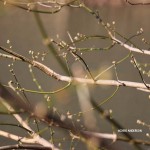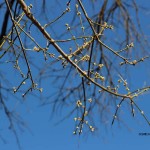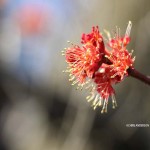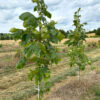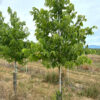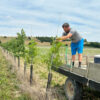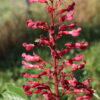Naturalist Stroll – White House Farm Foundation – Sat. March 21, 2015 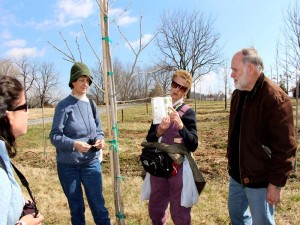 “We are in the rush of spring right now… the best of time to identify trees and early ephemerals – before the canopy closes in. If you have a place to be out in the woods, now is the time to go – plus it is cool, the sun is hitting the forest floor and there are fewer ticks,” Carrie Blair noted as we walked along the river trail at the White House Farm. The group convened on a chilly March morning with fog hanging over the river and the sky a rich gray over Massanutten Mountain. As the day progressed, the sun and our walk down Kauffmans Mill Road warmed the participants. This kicked off our 2015 ‘Naturalist Strolls’ at the farm when guest instructors share their expertise on various aspects of ecology. We were fortunate to be able to walk this morning with Carrie Blair, noting the early signs of spring and studying trees, wildflowers and the occasional weed bravely flowering in the chilly air. She urged us to look carefully for the early flush of color in certain trees indicating flowers – maples are currently exhibiting an aura of red, elms have a brown hue and willows appear yellow. These are welcome signs of color returning to the gray and brown of the winter landscape.
“We are in the rush of spring right now… the best of time to identify trees and early ephemerals – before the canopy closes in. If you have a place to be out in the woods, now is the time to go – plus it is cool, the sun is hitting the forest floor and there are fewer ticks,” Carrie Blair noted as we walked along the river trail at the White House Farm. The group convened on a chilly March morning with fog hanging over the river and the sky a rich gray over Massanutten Mountain. As the day progressed, the sun and our walk down Kauffmans Mill Road warmed the participants. This kicked off our 2015 ‘Naturalist Strolls’ at the farm when guest instructors share their expertise on various aspects of ecology. We were fortunate to be able to walk this morning with Carrie Blair, noting the early signs of spring and studying trees, wildflowers and the occasional weed bravely flowering in the chilly air. She urged us to look carefully for the early flush of color in certain trees indicating flowers – maples are currently exhibiting an aura of red, elms have a brown hue and willows appear yellow. These are welcome signs of color returning to the gray and brown of the winter landscape.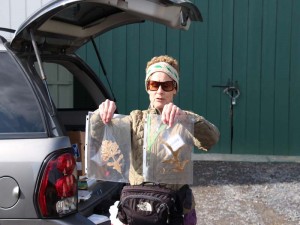 “The elm is common here and is very early to flower – they’ll produce their seed very soon even though spring has just begun.” She pointed out the large cottonwood trees growing near the river, noting that they are somewhat rare, particularly ones of such size. Ms. Blair pointed out the “chunky” bark in contrast to the smooth “muscled” bark of the ironwood leaning over the water.
“The elm is common here and is very early to flower – they’ll produce their seed very soon even though spring has just begun.” She pointed out the large cottonwood trees growing near the river, noting that they are somewhat rare, particularly ones of such size. Ms. Blair pointed out the “chunky” bark in contrast to the smooth “muscled” bark of the ironwood leaning over the water. 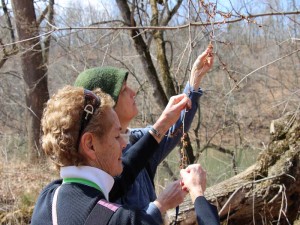 We admired the ash and linden trees at White House Natives, the nursery at the farm which now has 96 species of native trees and shrubs. The nursery presents a unique opportunity to easily study and identify natives, perfect for tree scholars and naturalists. As the nursery continues to grow – now extending over 15 acres – the trees support the local ecology by providing host plants to numerous larvae of native moths and butterflies, birds, bees and other pollinators. “The nursery is incredible and the efforts that you are making to replenish the native trees many people have not grown for the nursery trade or don’t know about are certainly laudable,” notes Ms. Blair.
We admired the ash and linden trees at White House Natives, the nursery at the farm which now has 96 species of native trees and shrubs. The nursery presents a unique opportunity to easily study and identify natives, perfect for tree scholars and naturalists. As the nursery continues to grow – now extending over 15 acres – the trees support the local ecology by providing host plants to numerous larvae of native moths and butterflies, birds, bees and other pollinators. “The nursery is incredible and the efforts that you are making to replenish the native trees many people have not grown for the nursery trade or don’t know about are certainly laudable,” notes Ms. Blair.  She got started studying trees when she married her husband who did tree work. An avid equestrian, she says she rode horses through many forested areas but couldn’t identify any of the tree species. She took a winter tree identification course through the National Wildlife Federation and from there started to identify numerous species, their habitats, benefits, etc. She says she has now studies trees for 40 years. “I probably lead [a walk] at least once a month or more. I go to many Virginia Native Plant Society events , [hear] Virginia Master Naturalist speakers … on many different things – butterflies, wildflowers … I just take any opportunity I can” Ms. Blair travels extensively and studies nature in various ecosystems including Vermont, New Jersey, Georgia and Florida and even plans a trip to Cuba in May. “We did a native plant trip to WV for a week last year which was fabulous and we are going to the Smokies in April and we are going to the Bruce Peninsula [in Canada] with the Botanical Society in June.” Along the walk, Ms. Blair provided tidbits of interesting information on many species: ailanthus seeds are identifiable due to the little twist in their shape, boxelder can continue to grow even when sediment builds up around the base of their trunk as often occurs in floodplains and every part of the spicebush is fragrant including the bark, leaves and seeds. Of the White House Farm, Ms. Blair notes that “the location and scenery is fabulous, almost unrivaled in Virginia, as far as I am concerned.” As often occurs when out in the woods, we encountered a few mysteries amongst the plants such as one shrub that had growths along its branches which were not easily identifiable as to cause. A gall? For those who enjoy studying nature and being outdoors, this was a perfect morning – noticing the natural world slowly awakening with the welcome return of sunlight and warmth and sharing information and company with fellow naturalists. Chris Anderson, executive director White House Farm Foundation
She got started studying trees when she married her husband who did tree work. An avid equestrian, she says she rode horses through many forested areas but couldn’t identify any of the tree species. She took a winter tree identification course through the National Wildlife Federation and from there started to identify numerous species, their habitats, benefits, etc. She says she has now studies trees for 40 years. “I probably lead [a walk] at least once a month or more. I go to many Virginia Native Plant Society events , [hear] Virginia Master Naturalist speakers … on many different things – butterflies, wildflowers … I just take any opportunity I can” Ms. Blair travels extensively and studies nature in various ecosystems including Vermont, New Jersey, Georgia and Florida and even plans a trip to Cuba in May. “We did a native plant trip to WV for a week last year which was fabulous and we are going to the Smokies in April and we are going to the Bruce Peninsula [in Canada] with the Botanical Society in June.” Along the walk, Ms. Blair provided tidbits of interesting information on many species: ailanthus seeds are identifiable due to the little twist in their shape, boxelder can continue to grow even when sediment builds up around the base of their trunk as often occurs in floodplains and every part of the spicebush is fragrant including the bark, leaves and seeds. Of the White House Farm, Ms. Blair notes that “the location and scenery is fabulous, almost unrivaled in Virginia, as far as I am concerned.” As often occurs when out in the woods, we encountered a few mysteries amongst the plants such as one shrub that had growths along its branches which were not easily identifiable as to cause. A gall? For those who enjoy studying nature and being outdoors, this was a perfect morning – noticing the natural world slowly awakening with the welcome return of sunlight and warmth and sharing information and company with fellow naturalists. Chris Anderson, executive director White House Farm Foundation
© DynamicFrameworks - Elite ThemeForest Author.



